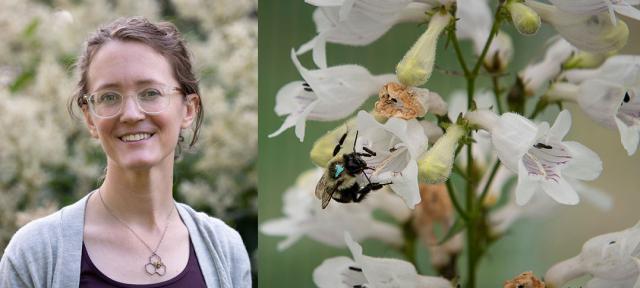Introducing Assistant Professor of Ecology and Global Change Jennifer VanWyk

Hampshire College is pleased to welcome a number of exciting new professors to campus to support its fall class.
Before joining the faculty at Hampshire, Jennifer VanWyk taught a variety of courses at a range of institutions: the University of Massachusetts Amherst, the University of California, Davis, Cal State Chico, and Mount Holyoke College. She most often taught ecology and specialized courses in botany and entomology, and occasionally environmental studies/policy. This semester she’ll get to teach a favorite course, developed down the street at Mount Holyoke, called Disease Ecology. Next semester, she hopes to offer Insects in Agriculture with the Hampshire College Farm.
VanWyk holds a B.A. in biology with a concentration in botany and geology from Vassar College and earned her M.S. and Ph.D. in ecology from the University of California, Davis.
What are you passionate about when it comes to this work?
As a botanist, entomologist, agroecologist, and ecophysiologist, I specialize in researching and teaching about the factors influencing community dynamics for native bee and plant populations. A significant aspect of my teaching and research addresses how plant and insect traits mediate both mutualistic and antagonistic species interactions, and how these interactions affect bee-population dynamics and broader ecological outcomes.
I’ve spent a great deal of time thinking about questions such as:
- Can the shape of a flower predict how bee pathogens are spread between bees?
- How does the body size of a bee impact pathogen transmission?
- What does pollinator health look like in a changing climate: how do multiple stressors interact to impact fitness, behavior, and immune function?
- What does a plant and a pollinator community look like in a restored wetland over time?
- How do wildfires affect pollination in rare plants?
- How can entomologists change the language we use in beekeeping to be anti-racist?
- If its hairy leaves become covered in pollen, can a plant defend against herbivory?
- What visual cues are butterflies using to make foraging decisions?
- Are sick bees bad pollinators?
I’m utilizing my current USDA grant investigating the eco-physiological impacts of climate change and pathogen stress on bumblebees, and then using that information to assess the impacts on crop pollination. Understanding how exposure to environmental stressors impacts pollinator health and ecosystem services has important conservation and economic implications, and is a cornerstone of agricultural climate adaptation.
This spring I’ll be testing this with strawberries in the Cole greenhouse. But please don’t eat the research!
Have you been in any other professions that impacted how you teach and learn?
Fun fact: My last name rhymes with bike, which is convenient because I love bikes. I’m a bike mechanic, and during my Ph.D. I ran a workshop series at a nonprofit bicycle collective in California called “Women-Trans-Femme Bike Night.” I’d argue that teaching someone how to wrestle with their rusted and busted bottom bracket is not all that different from teaching someone statistics or plant ID. It all takes a lot of patience and meeting people where they are when they come into a classroom/bike shop/lab/life.
What are you looking forward to at Hampshire?
I hope to never stop learning here.
Recently I’ve begun to apply new technology in novel ways to study bees and explore physiological responses to stress, including machine learning on automated video recording, audio files to quantify pollination and muscle coordination, motion sensors to assess circadian rhythms, Arduino-based respirometers to measure metabolic processes, and thermal cameras to see if bees get fevers. Hampshire is an exciting place for me to work with students who are technologically savvy who might not otherwise have been thinking about bees or ecology to foster cross-disciplinary collaborations.
Bee photo above by Ben Barnhart. “We painted the bee blue for the research,” says VanWyk.



